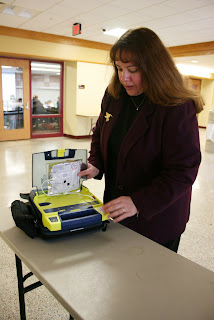Pitt-Bradford Places Defibrillators
On Campus for Heart Safety
 The University of Pittsburgh at Bradford is a more heart-safe campus thanks to the placement of seven new automated external defibrillators in academic buildings on campus.
The University of Pittsburgh at Bradford is a more heart-safe campus thanks to the placement of seven new automated external defibrillators in academic buildings on campus.The seven new defibrillators are in addition to three of the devices that already existed on campus. Simple-to-use AEDs can now be found in the lobbies of the Sport and Fitness Center, the Frame-Westerberg Commons, Swarts Hall, Fisher Hall, Hanley Library, Blaisdell Hall, the Hangar Building and the Seneca Building downtown.
In addition, campus police carry a portable unit and another portable unit travels with Pitt-Bradford sports teams.
Dr. Jean Truman, assistant professor of nursing, was chairwoman of the faculty senate’s health and safety committee at the time that it recommended purchasing and installing the units. A corporate buy-down grant was secured, and the office of the president contributed to the $10,000 cost.
In combination with effective cardio-pulmonary resuscitation, the units do not require those helping sudden cardiac victims to have any additional training.
“If someone needs help, most people want to help, and this gives them a greater ability to do so,” Truman said.
In the event that someone collapses, a witness opens a glass case housing the AED and removes the unit. The unit can be easily taken to another part of a building or even outside. Opening the glass case sets off a loud chirping alarm designed to draw others to the area to help give assistance.
As soon as the case to the unit is opened, a loud, automated voice gives instructions. The caregiver removes the victim’s shirt and places two adhesive pads on the victim’s chest. The machine will read the victim’s heart rhythm to determine whether a shock is appropriate.
If a shock is needed, the unit instructs the operator to push a button for the AED to deliver the life-saving shock.
The most common cause of sudden cardiac death is a quivering of the heart’s lower chambers. AEDs work by shocking the heart, allowing it to “reset” its own natural electrical rhythm.
The death rate from heart attacks increases up to 10 percent with every minute that goes by without defibrillation and CPR, according to the American Heart Association. After 10 minutes without defibrillation, a person who is suffering from a heart attack has less than a 10 percent chance of survival.
“This initiative is one means of bridging the gap of time to defibrillation and saving lives,” Truman said
Pictured, Dr. Jean Truman, assistant professor of nursing at the University of Pittsburgh at Bradford, demonstrates one of the new automated external defibrillators on campus.
(Photo courtesy of Pitt-Bradford)

.jpg)

Comments